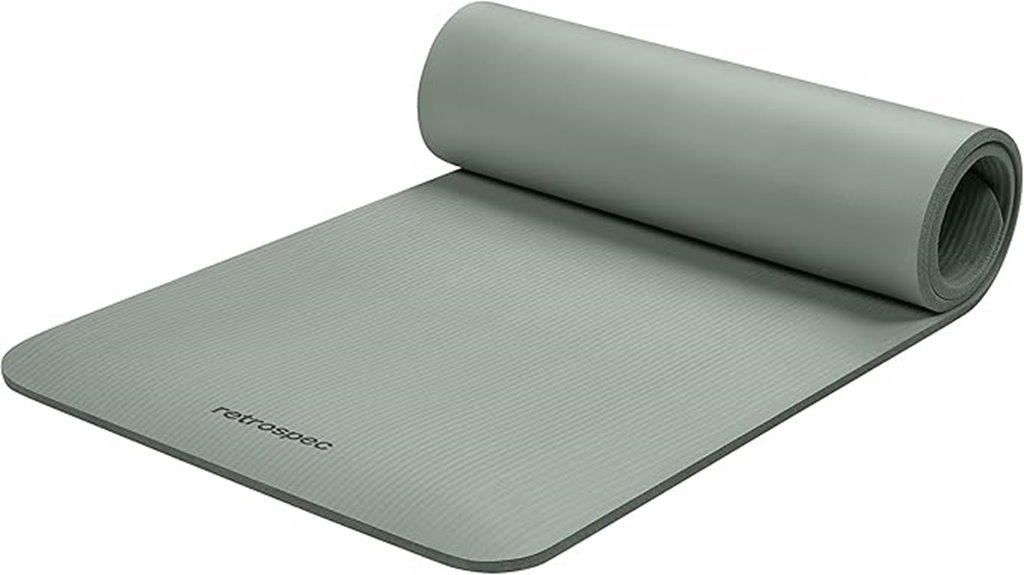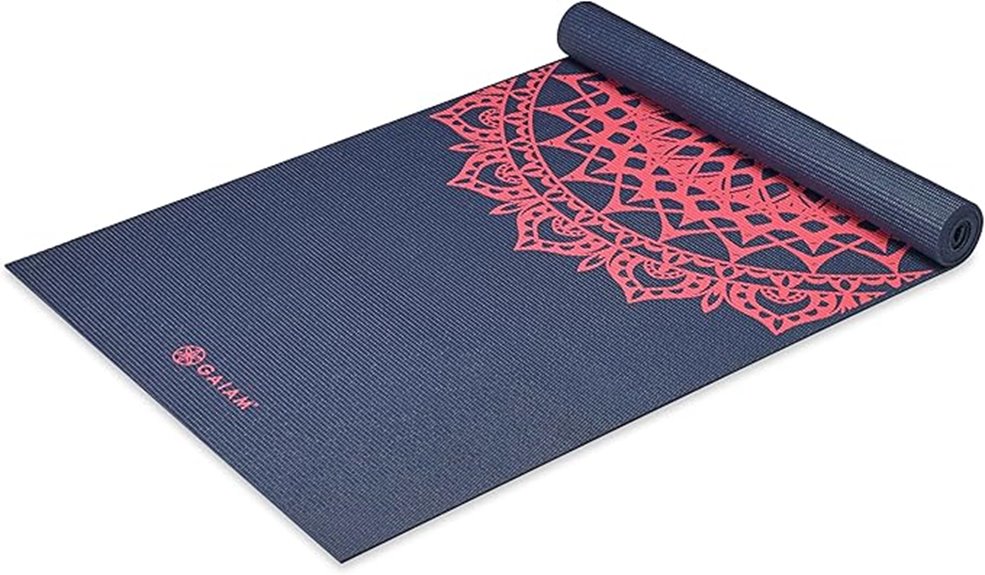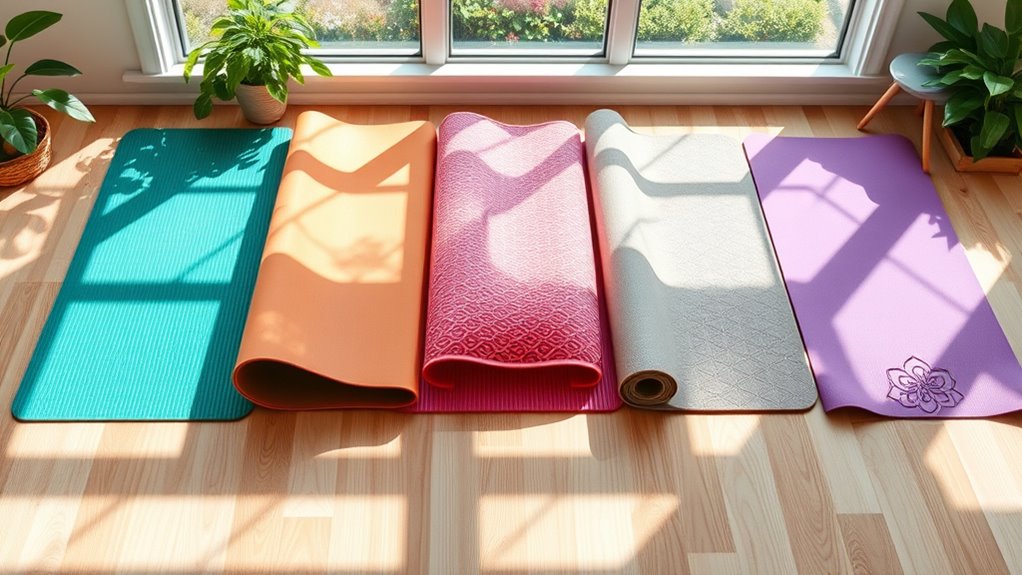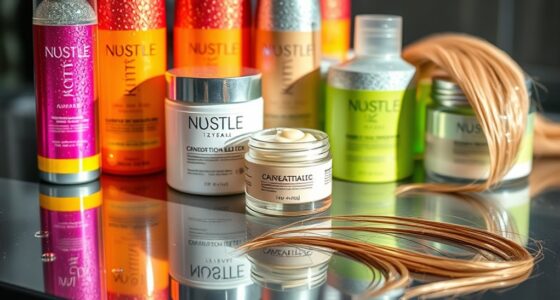If you’re new to yoga, choosing the right non-slip mat can boost your confidence and safety during practice. I recommend considering options like extra-thick mats for joint support, textured surfaces for reliable grip, and lightweight designs for portability. Durable, eco-friendly materials also matter for long-term use. To find the best fit for your needs, explore the top choices available, and you’ll uncover more tips to enhance your practice along the way.
Key Takeaways
- Choose mats with textured, non-slip surfaces like PVC or TPE for reliable grip during various poses.
- Opt for thicker mats (0.25–0.5 inches) to provide comfort and joint support for beginners.
- Select size and weight options that balance stability with portability for easy transport and storage.
- Prioritize eco-friendly, SGS-certified materials for safety, durability, and reduced odor.
- Look for mats with practice guides, extra cushioning, and carrying straps to enhance beginner experience.
Amazon Basics Extra Thick Exercise Yoga Mat with Carrying Strap

If you’re just starting out with yoga or daily exercise, the Amazon Basics Extra Thick Exercise Yoga Mat with Carrying Strap is a great choice because its 0.5-inch thickness provides extra cushioning and shock absorption. Made of durable 100% NBR foam, it offers reliable support during your workouts. The textured surface enhances traction, helping you stay stable in various poses. Its generous dimensions (74 x 24 inches) give ample space to move comfortably. Plus, the elastic strap makes it easy to carry and store. Whether at home or on the go, this mat combines comfort, durability, and portability to support your beginner fitness journey.
Best For: beginners or anyone seeking a comfortable, durable, and portable yoga or exercise mat for daily workouts at home or on the go.
Pros:
- Extra thick 0.5-inch cushioning provides excellent shock absorption and comfort
- Textured surface enhances traction for stability in various poses
- Lightweight with an elastic strap for easy transport and storage
Cons:
- May be too thick for advanced practitioners preferring a closer ground feel
- NBR foam may wear over time with frequent use
- Larger dimensions may be cumbersome for very limited storage spaces
Instructional Yoga Mat with Carrying Strap

The Instructional Yoga Mat with Carrying Strap is an excellent choice for beginners who want guided support and easy portability. Measuring 68”x24” with a 0.25” thickness, it features 75 illustrated yoga poses and 75 stretching exercises printed directly on the surface, making self-guided practice simple. Made from eco-friendly, SGS-certified non-toxic PVC, it offers a non-slip surface for safety during vigorous sessions. Weighing only 3.7 pounds and equipped with a convenient carry strap, it’s perfect for travel, studio, or home use. Its vibrant dual-sided colors and durable construction ensure lasting quality, supporting your yoga journey with clarity and comfort.
Best For: beginners and experienced yoga practitioners seeking guided poses, portability, and a safe, comfortable practice surface.
Pros:
- Printed instructions with 75 yoga poses and stretching exercises simplify learning and practice.
- Eco-friendly, non-toxic PVC material ensures safety, durability, and quick odor dissipation.
- Lightweight design with a carrying strap makes it easy to transport for home, studio, or travel use.
Cons:
- Hand wash only, which may be less convenient for routine cleaning.
- Thickness of 0.25” may be less cushioned for those needing extra padding.
- Limited color options or customization beyond dual-sided vibrant colors.
Retrospec Solana Yoga Mat with Nylon Strap

The Retrospec Solana Yoga Mat with Nylon Strap stands out for beginners thanks to its ample 1/2-inch thickness, which offers extra cushioning for joints, hips, and knees during floor exercises. This extra padding makes poses more comfortable and reduces strain, especially during Pilates, stretching, or strength training. The non-slip surface grips floors securely, ensuring stability and preventing slips. Built for durability, it can handle daily use at home or in the studio. The included nylon strap makes it easy to carry and store, so you can practice anywhere. Made from BPA-free materials, it’s easy to clean, keeping your practice safe and hygienic.
Best For: Beginners and casual practitioners seeking a comfortable, stable, and portable yoga mat for home or studio use.
Pros:
- Provides 1/2-inch thick cushioning for enhanced joint and knee support
- Features a non-slip surface for secure stability during workouts
- Durable construction suitable for daily use and intense sessions
Cons:
- May be too thick for those preferring a closer connection to the ground
- Slightly heavier than thinner mats, which could affect portability for some users
- Requires regular cleaning to maintain hygiene, especially with frequent use
Retrospec Solana Yoga Mat with Nylon Strap

Looking for a yoga mat that combines comfort, stability, and portability? The Retrospec Solana Yoga Mat is a great choice. It’s 1 inch thick, offering extra cushioning to protect your joints during poses. Measuring 72 x 24 inches, it’s versatile for yoga, Pilates, and stretching. The non-slip surface keeps you steady, even during sweaty sessions. Plus, the included nylon strap makes it easy to carry around, whether you’re heading to class or practicing at home. Made from durable, eco-friendly materials, it’s built to handle daily use. Just remember to air it out before use to avoid any initial odor.
Best For: individuals seeking a comfortable, stable, and portable yoga mat suitable for various exercises like yoga, Pilates, and stretching.
Pros:
- Extra thick (1 inch) cushioning provides excellent joint support and comfort
- Non-slip surface ensures stability during even sweaty workouts
- Comes with a nylon strap for easy transportation and convenience
Cons:
- Initial odor may require airing out before use
- Slightly heavier than thinner mats, which may affect portability for some users
- Requires gentle cleaning and air drying to maintain its quality over time
Gaiam Print Yoga Mat for Yoga, Pilates & Floor Exercises

If you’re new to yoga or Pilates and want a reliable mat that offers both comfort and grip, the Gaiam Print Yoga Mat is an excellent choice. It’s lightweight, durable, and portable, making it perfect for various exercises. The non-slip textured surface provides excellent traction, so you stay stable during poses. Made from non-toxic, 6P-free PVC, it’s safe for both you and the environment. At 68 inches long and 4mm thick, it offers good cushioning to protect your joints. Plus, it includes a free downloadable workout, helping you get started and stay motivated on your fitness journey.
Best For: beginners and experienced practitioners seeking a reliable, eco-friendly yoga mat with good grip and cushioning for various floor exercises.
Pros:
- Non-slip textured surface provides excellent traction and stability during poses
- Made from non-toxic, 6P-free PVC, ensuring safety for health and the environment
- Lightweight and portable, ideal for use at home or on the go
Cons:
- May require airing out for a few days to reduce initial odor
- Thickness of 4mm might be less cushioned for high-impact routines
- Limited color or design options compared to more decorative mats
Factors to Consider When Choosing a Yoga Mat for Beginners Non Slip

When choosing a non-slip yoga mat, I look at the surface material to guarantee it provides reliable grip during poses. I also consider thickness for comfort and support, along with size and portability for convenience. Finally, I check how easy it is to clean and how durable the mat is for long-term use.
Non-Slip Surface Material
Choosing the right non-slip surface material is essential because it directly impacts your safety and stability during yoga practice. Textured materials like PVC or TPE offer superior grip, helping you stay steady in challenging poses. The surface texture plays a big role; deeper patterns improve traction on various floors, giving you confidence with every move. I also look for eco-friendly, non-toxic options that keep my practice safe without sacrificing slip resistance. Durability matters too—quality materials resist wear and maintain grip over time, saving me from frequent replacements. A good non-slip surface not only keeps me balanced during gentle stretches but also supports stability during more vigorous or dynamic exercises. Ultimately, choosing the right material helps me feel secure and focused on my practice.
Cushioning and Thickness
The thickness of a yoga mat plays a significant role in how comfortable and supportive your practice feels. Thicker mats, around 0.5 to 1 inch, provide extra cushioning that reduces pressure on your joints, making poses more comfortable and helping prevent injuries. They’re ideal if you have sensitive knees or wrists or want extra comfort during floor exercises. On the other hand, thinner mats, about 0.25 inches, offer better stability and closer contact with the ground, which can improve balance and control. Finding the right balance is key—too thick might compromise stability, while too thin might lack enough shock absorption. A good cushion can help you maintain proper alignment and posture, making your beginner practice safer and more enjoyable.
Size and Portability
Selecting the right size and portability features for your yoga mat can make a big difference in your practice experience. A longer mat, around 68-74 inches, gives you enough space for a variety of poses and movements, which is especially helpful as you progress. If you often practice outdoors or at different locations, a lightweight, portable mat with features like carrying straps makes transportation easier. Thicker mats, about 0.5 inches, provide extra cushioning on hard floors, enhancing comfort during longer sessions. For travel, compact or foldable mats are convenient—they fit easily into bags or small storage spaces. Also, consider the weight; mats under 4 pounds are easier to carry without sacrificing stability, making your yoga practice more accessible wherever you go.
Durability and Longevity
Durability and longevity are essential factors when picking a yoga mat, especially for beginners who want something that can withstand regular practice. High-quality materials like PVC, TPE, or NBR foam are key because they resist tearing and wear over time. Thicker mats, around 0.5 inches or more, tend to last longer since they absorb impact and reduce surface wear. Mats with reinforced edges and non-slip surfaces are less prone to fraying, maintaining safety and integrity through frequent use. Proper care also extends your mat’s life—regular cleaning and avoiding prolonged sunlight or moisture exposure help preserve its shape and traction. Investing in a well-constructed, eco-friendly mat guarantees durability, so it remains comfortable and safe, even with consistent practice.
Ease of Cleaning
When choosing a yoga mat, ease of cleaning plays a big role in maintaining hygiene and ensuring a fresh practice environment. A mat that’s simple to clean helps prevent the buildup of sweat, dirt, and bacteria, keeping it fresh and safe for regular use. Materials like PVC, NBR foam, or TPU are great because they can be easily wiped down with a damp cloth or mild soap. While textured surfaces might need a bit more attention to remove dirt from grooves, they still remain manageable. Some mats are even machine washable, offering a deep clean when needed. Quick-drying mats are especially convenient, allowing me to clean and reuse them without long wait times, making regular maintenance quick and hassle-free.
Eco-Friendly Materials
Eco-friendly yoga mats are a smart choice for beginners who want to reduce their environmental footprint while practicing. These mats are made from sustainable materials like natural rubber, jute, or cork, which help lower environmental impact. Unlike synthetic options, they’re non-toxic and often SGS-certified, free from harmful chemicals such as phthalates and heavy metals, making them safer for your skin. Biodegradable materials mean the mats break down naturally over time, reducing landfill waste. Plus, eco-friendly mats help prevent off-gassing odors and skin irritation caused by chemical-laden products. Many of these materials come from renewable resources and are produced through processes that lower carbon footprints. Choosing an eco-conscious mat supports sustainability without sacrificing performance or safety.
Price and Value
Choosing the right yoga mat involves balancing cost with features that add value to your practice. Prices for beginner mats typically range from $15 to $50, depending on thickness, material, and brand. Investing in a higher-value mat with features like extra cushioning and a non-slip surface can improve safety and comfort, making your practice more enjoyable. Cheaper mats might wear out quickly or lack sufficient grip, leading to more frequent replacements and higher long-term costs. Some options include added features like carrying straps or eco-friendly materials, which can justify a higher price for better overall value. Comparing prices and features helps you find a mat that offers durability, safety, and affordability, ensuring you get the best bang for your buck and support your progress as a beginner.
Additional Features
Adding extra features to a yoga mat can make a big difference in how easy and enjoyable your practice is. Carrying straps or handles make transportation simple, so you can take your mat anywhere. Some mats have printed guides or pose illustrations directly on the surface, helping you maintain proper alignment and stay confident during sessions. Textured surfaces improve grip, especially when you sweat, reducing the risk of slips. If you need extra cushioning, choose a thicker mat—around 0.5 to 1 inch—to protect sensitive joints and knees. Eco-friendly and non-toxic materials like SGS-certified PVC or foam not only ensure safety but also support sustainable practices. These added features can profoundly enhance comfort, safety, and convenience for beginners just starting their yoga journey.
Frequently Asked Questions
How Do I Clean and Maintain My Non-Slip Yoga Mat?
To clean and maintain my non-slip yoga mat, I usually wipe it down after each practice with a mixture of water and a gentle, mild soap or a specialized yoga mat cleaner. I avoid harsh chemicals that could damage the surface. I also air dry it completely before rolling it up. Occasionally, I deep clean with a vinegar solution to remove buildup and keep the grip intact.
What Thickness Is Best for Beginner Non-Slip Yoga Mats?
For beginners, I recommend a yoga mat that’s about 4 to 6 mm thick. This thickness provides enough cushioning for your joints without compromising stability. Thinner mats, around 3 mm, can be great if you prefer more ground contact, while thicker ones offer extra comfort but might make balancing a bit trickier. I’ve found 4-6 mm strikes a good balance for safety, comfort, and stability during practice.
Are There Eco-Friendly Non-Slip Yoga Mats Available?
Yes, there are eco-friendly non-slip yoga mats available. I’ve found options made from natural materials like cork, jute, and recycled rubber that offer great grip without harming the environment. These mats are perfect if you want to practice mindfully and sustainably. I recommend looking for certifications like OEKO-TEX or Green Guard to guarantee you’re choosing genuinely eco-friendly products. They help you stay committed to both your practice and the planet.
How Often Should I Replace My Yoga Mat for Optimal Grip?
Did you know that over 50% of yoga practitioners replace their mats every 6 to 12 months? I recommend swapping out your yoga mat every year for maximum grip. As you use it, sweat and dirt can break down the surface, reducing traction. If your mat starts slipping or shows visible wear, it’s time for a replacement. Keeping your mat fresh ensures safety and better performance in every pose.
Can Non-Slip Yoga Mats Be Used for Outdoor Practice?
Absolutely, non-slip yoga mats are great for outdoor practice! I’ve used mine in parks, on grass, and even on sandy beaches. They provide the stability and grip needed to stay balanced, no matter the surface. Just make sure to clean your mat afterward to remove dirt and debris. With the right care, your non-slip mat can handle outdoor sessions, helping you stay focused and safe wherever you practice.
Conclusion
So, if you’re serious about staying stable and slipping less, selecting a sturdy, non-slip yoga mat is essential. Remember, the right mat can make your movement more mindful and your practice more pleasurable. Prioritize padding, grip, and portability to perfect your pose and progress. With the perfect non-slip mat in hand, you’ll confidently conquer curls, stretches, and sequences—making every session a seamless, satisfying step toward your yoga goals.









